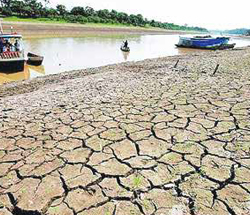Managing Agricultural Risks

While handicapping growth, unmanaged risks are also a significant factor contributing to chronic poverty in Kenya. Shocks to agricultural production and markets adversely impact household wellbeing in a variety of ways: by limiting food availability, weakening food access, and negatively affecting future livelihoods through income disruption and depletion of productive assets.
Chronically vulnerable groups with high exposure to risks experience a disproportionately large impact from adverse events and typically lack coping mechanisms available to other groups. Understanding these and other risk dynamics is key to developing appropriate risk management responses that can help reduce production volatility, safeguard livelihoods, and put the sector and the broader economy on a firmer footing for growth. Effective strategies can also make a meaningful contribution to poverty reduction efforts.
Management of agricultural risk is not new to Kenya. The Government of Kenya has a long track record of investing in risk mitigation, transfer, and coping mechanisms. Moving forward, Kenya’s Vision 2030 recognizes the need to strengthen existing risk management systems and the Government has launched a range of new initiatives to confront the most severe threats facing the country.
Kenya’s agricultural supply chains remain highly vulnerable to myriad risks that disrupt the country’s economic growth, cripple poverty reduction efforts, and undermine food security. A more targeted and systematic approach to agricultural risk management is needed in Kenya.
 Strengthening Resilience
Strengthening Resilience
Strengthening ex ante resilience requires moving beyond individual practices to integrate through a whole-farm and wholelandscape systems approach. Many gains will come though better and more equitable management of natural resources such as soil, water, and landscapes, which will require knowledge generation and sharing, and integration of investments at multiple levels. These will need to be supported by policy and institutional reforms.
Equally critical will be ensuring that producers have good access to needed productive inputs, including market and weather information, credit, and well functioning markets.
Based on an assessment of existing risk management practices and programs in Kenya, the following recommendations are tailored to address Kenya’s unique risk landscape, fill existing gaps, and scale up effective strategies. The interventions encompass a broad range of interrelated, mutually supportive investments that align with the Livelihoods Enhancement goals within Vision 2030 and aim to strengthen the resilience of vulnerable farming to shocks.
1. Improved Water and Soil Management
Addressing climate-change-induced water stress and promoting better water-use efficiency, particularly in marginal rainfall zones, will be required to strengthen resilience in Kenya’s agricultural sector. Similarly, curbing soil erosion, increasing soil fertility, and improving access to high-quality, drought- and disease-tolerant seed varieties are crucial to enhancing the productivity of smallholder systems. In most parts of the country, access to irrigation remains limited, and farmers are at the mercy of rainfall.
Perception of high production risks drives their ex-ante decisions and discourages them from investing in fertilizers, improved seeds, and better crop husbandry practices. Irrigation infrastructure build-out is costly and not suitable for many areas where long-term access to groundwater is uncertain. However, water harvesting and improved soil management offer a sustainable and cost-effective way to favour investments in yieldenhancing practices.
In order to strengthen risk management at the farm level, increase the effectiveness of productivity-enhancing programs, and improve the effectiveness of public support systems, the following is recommended:
Incentives
• Incentivize farmer/community–driven investments in improved rainwater harvesting and storage measures such as terracing, water harvesting pans, roof and rock catchment systems, multipond systems, furrows, small basins, sub-surface dams, and micro irrigation systems.
Broader Awareness
• Promote broader awareness and adoption (via Farmer Field days and other participatory extension approaches) of improved soil and water conservation practices such as zero tillage, mulching, integrating livestock, composting and use of organic fertilizers, crop diversification and rotation, terracing and grass strips, and agroforestry.
Stronger Linkages
• Create stronger linkages with continental-level initiatives such as the Comprehensive Africa Agriculture Development Programme’s African Alliance for Climate Smart Agriculture to better leverage expertise and scale up best practices technologies.
Strong Management
• Strengthen management of subsidized seed and fertilizer distribution schemes to better incentivize farmers to adopt “best practice” soil and water conservation technologies that build climate resilience and improve productivity.
Research
• Strengthen seed research, developing credible and commercially-driven certified seed production and distribution systems, and upgrade monitoring and enforcement of seedquality standards to curb counterfeiting and adulteration.
• Create linkages between research centres and county governments to ensure that nationally funded research is aligned with farmers’ needs and county development priorities. Support research to address gaps in the empirical evidence related to the costs/benefits of climate smart adaptation and mitigation technologies.
2. Climate Services for Better Decision Making
Improving the productivity and climate resilience of smallholder farmers and pastoralists requires timely, cost-effective, and relevant information on improved agricultural practices, markets, prices, inputs, weather, and news of impending disasters. Yet, access to and quality of these climate and market information services are critically low or non-existent developing integrated, modern agro-weather forecasting and marketing information systems to equip farmers with the right information to make better decisions and manage climate variability.
These tools will also enhance extension services delivery by providing advice on agronomic best practices, agro-input use, storage technologies, and marketing of production.
Weather
Upgrade existing weather infrastructure and install new automated weather stations to improve agro-weather observation monitoring.
Strengthen institutional capacity for downscaling climate models, numerical weather prediction modelling, processing and satellite weather data analysis, visualization of the data, and improved weather communications in conjunction with national and international universities.
Develop big data crop-weather analytics to help reduce risks and uncertainties, and assist farmers in making decisions on what, when, and where to plant. Leverage multiple delivery channels (traditional extension, radio, SMS) to disseminate weather and market advisories to rural farmers and pastoralists. These delivery channels should be integrated with the agro-weather and market information support systems and allow for bi-directional information exchange to maximize collection of data from farmers.
Conclusions
The risk assessment process highlight opportunities for strengthening the climate resilience of Kenya’s agricultural sector. The country is currently undergoing a revolutionary transformation within its political, fiscal, legal, and administrative makeup. Launched in 2012, the devolution process has decentralized power and resources across key sectors of the economy to local levels of government.
For agriculture, this means that 47 county governments are now in the driver’s seat. While this presents near-term challenges, it also presents a unique opportunity for more localized and more targeted planning and decision making on agricultural sector growth and development priorities.
It also empowers more localized, more effective responses to the growing threat of climate variability and extreme weather